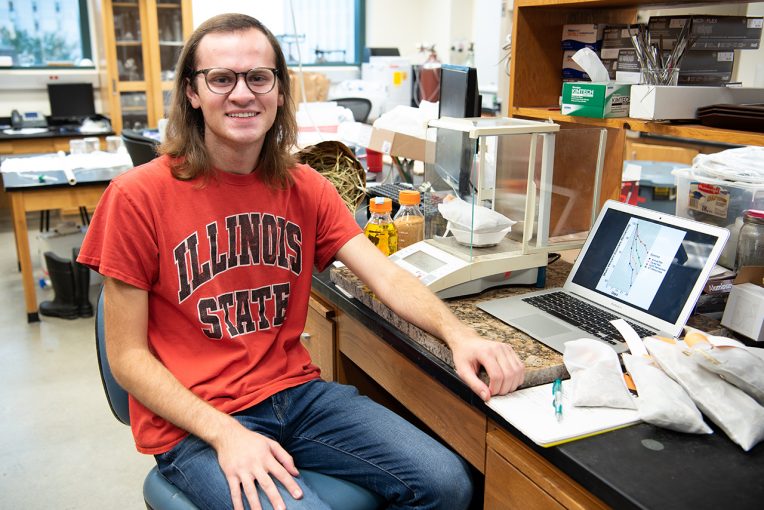Alex Hafner, a senior from Mahomet, decided to pursue a major in molecular and cellular biology due to his interest in research. This same passion drew him to Western Illinois University’s undergraduate research experience this summer, where he continued his participation in the Integrated Pennycress Research Enabling Farm & Energy Resilience (IPREFER) Project.
This long-term research project heavily involves Illinois State faculty and students who are working with colleagues at Western Illinois University and other entities to transform wild pennycress into a genetically modified, high-yield oilseed crop that would be grown in the winter in fields devoted in warmer months to corn and soybeans. Cover crops are beneficial to farming as they allow the field to retain nutrients which decreases the need for harmful fertilizers and helps maintain the quality of the soil. Additionally, domesticated pennycress can be processed into biofuel, jet fuel, animal feed, and other products.
“Normally cover crops aren’t able to generate any profit, but this crop in particular has the potential to since it can be turned into oil as well,” Hafner said. “So while it’s in the field, it’s providing good things for the environment, but then after it’s harvested, it doesn’t just go to waste.”
This summer was not the first time Hafner participated in research with IPREFER. After finding out about the study from a teaching assistant in his freshman biology class, Hafner spent his sophomore and junior years assisting in pennycress research in Dr. John Sedbrook’s genetics lab. Sedbrook is leading the pennycress project at Illinois State. Hafner then went on to hold a summer intern position with IPREFER in St. Louis last year, where his work was lab-based rather than field-based, and the focus was creating mutations in the plant’s genome that would speed up flowering time to optimize pennycress as a cover crop.
During his internship this summer, he monitored the efficiency of pennycress when it is actually put to use.
To test whether pennycress is an efficient cover crop, four crops—cereal rye and annual rye (common cover crops), wild pennycress, and genetically modified pennycress—were planted in fall 2020. The two rye crops and the wild pennycress were planted at the University farm at Lexington, and the modified pennycress was provided by IPREFER collaborators. Throughout the course of the 12-week internship, Hafner pulled and analyzed soil samples to learn more about crop decomposition speed and nutrient release rates.
Because the corn growing season has not finished, Hafner’s team has yet to gather all the data; however, the preliminary research highlights the crop’s decomposition rate—an important aspect of the life cycle of pennycress. Decomposition rate is important to the consideration of pennycress as a cover crop, as corn has a set growing season, and must be fertilized at a specific time. Understanding how quickly pennycress releases nutrients into the soil will provide an idea of when in the corn-growing season the soil is fertile.
“We can see now early on that these cover crops are decomposing at the same rate. So that way farmers will be able to make decisions on what cover crops they want to plant based on that,” Hafner said. This allows farmers to offset fertilizer applied during the year, saving them money and reducing harmful runoff.
Details on Hafner’s research and preliminary findings were shared at IPREFER’s annual meeting, which took place August 10–11 over Zoom.
After completing his undergraduate education, Hafner hopes to build upon what he’s learned at Illinois State as well as what he learned throughout the internship to continue studying plant genetics, and pursue further research on how they can be used to better the environment.
“I learn best by doing, so the opportunity to apply the concepts I learn about in class in both lab and field work is very rewarding,” Hafner said, “This experience has allowed me the opportunity to get hands-on experience in the field and learn many new techniques. I am very thankful to Dr. (Bill) Perry for working with me and teaching me some of what he knows this summer. I feel more comfortable pursuing a career in research because of this experience.”

